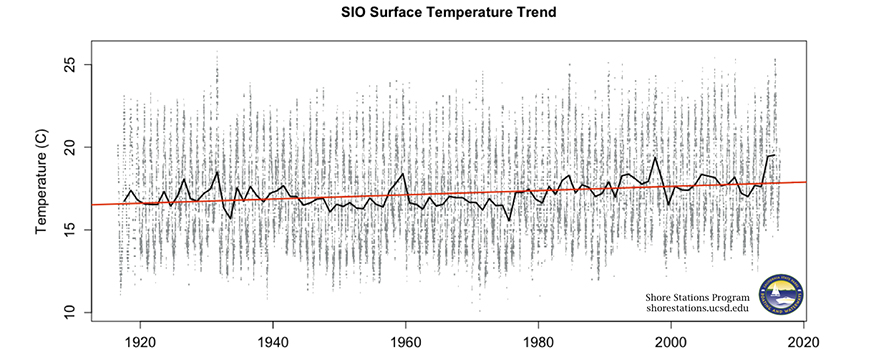Global S&T Development Trend Analysis Platform of Resources and Environment
| Voyager: How Has Climate Change Affected the Oceans at a Local Level, Particularly La Jolla Shores (San Diego, Calif.)? | |
| admin | |
| 2017-01-12 | |
| 发布年 | 2017 |
| 语种 | 英语 |
| 国家 | 美国 |
| 领域 | 资源环境 |
| 正文(英文) |  Scripps Pier record of ocean temperature trend Well before humans settled in what is now San Diego, natural climate variability was changing the look of the California coastline. Some 20,000 years ago, sea level in Southern California was lower than it is now by 120 meters (400 feet), the equivalent of a 50-story building. The current San Diego coastline would have been well inland then. The melting of glaciers that ushered in the current interglacial period has elevated sea level since, with the natural rise tapering off in the last millennium. In the past century, sea level has risen by about two millimeters (0.078 inches) per year, nearly an inch per decade. Researchers here at Scripps have estimated that sea level in La Jolla will be about 300 millimeters (12 inches) higher in 2050 than it was in 2000, with the accelerated rise due to melting glaciers and the thermal expansion of seawater in response to human-induced climate change. The record of warming ocean temperatures at Scripps Pier is one of many datasets that helped scientists identify the recent global trend. The difficulties of predicting future greenhouse gas emissions and the associated glacial melt rates contribute to the uncertainty in sea level rise projections. While a few inches of sea-level rise may not sound like much, it can significantly influence coastal flooding and erosion. The largest flood of the last 100 years is predicted to be an annual occurrence 50 years from now because of the rising seas. La Jolla Shores and other sites around San Diego County already flood with the right combination of waves, high tides, and sometimes El Niño. During last year’s El Niño, local sea level elevated as much as 30 centimeters (11 inches) above predicted heights between October 2015 and April 2016. The event changed the shape of the coast, causing widespread beach erosion in Southern California, while also pushing enough sand into estuaries to close off river mouths. Monitoring the coast's response to temporarily higher water levels during El Niño years will help coastal managers prepare for longer-term changes in sea level. -- Robert Guza and Ron Flick are oceanographers and Bonnie Ludka a postdoctoral researcher in the Integrative Oceanography Division at Scripps Institution of Oceanography, UC San Diego This story appears in explorations now, Scripps Institution of Oceanography's award-winning ocean and earth science magazine. Sign up to receive our free monthly story roundup.
|
| URL | 查看原文 |
| 来源平台 | Scripps Institution of Oceanography |
| 文献类型 | 新闻 |
| 条目标识符 | http://119.78.100.173/C666/handle/2XK7JSWQ/107645 |
| 专题 | 资源环境科学 |
| 推荐引用方式 GB/T 7714 | admin. Voyager: How Has Climate Change Affected the Oceans at a Local Level, Particularly La Jolla Shores (San Diego, Calif.)?. 2017. |
| 条目包含的文件 | 条目无相关文件。 | |||||
| 个性服务 |
| 推荐该条目 |
| 保存到收藏夹 |
| 查看访问统计 |
| 导出为Endnote文件 |
| 谷歌学术 |
| 谷歌学术中相似的文章 |
| [admin]的文章 |
| 百度学术 |
| 百度学术中相似的文章 |
| [admin]的文章 |
| 必应学术 |
| 必应学术中相似的文章 |
| [admin]的文章 |
| 相关权益政策 |
| 暂无数据 |
| 收藏/分享 |
除非特别说明,本系统中所有内容都受版权保护,并保留所有权利。
修改评论